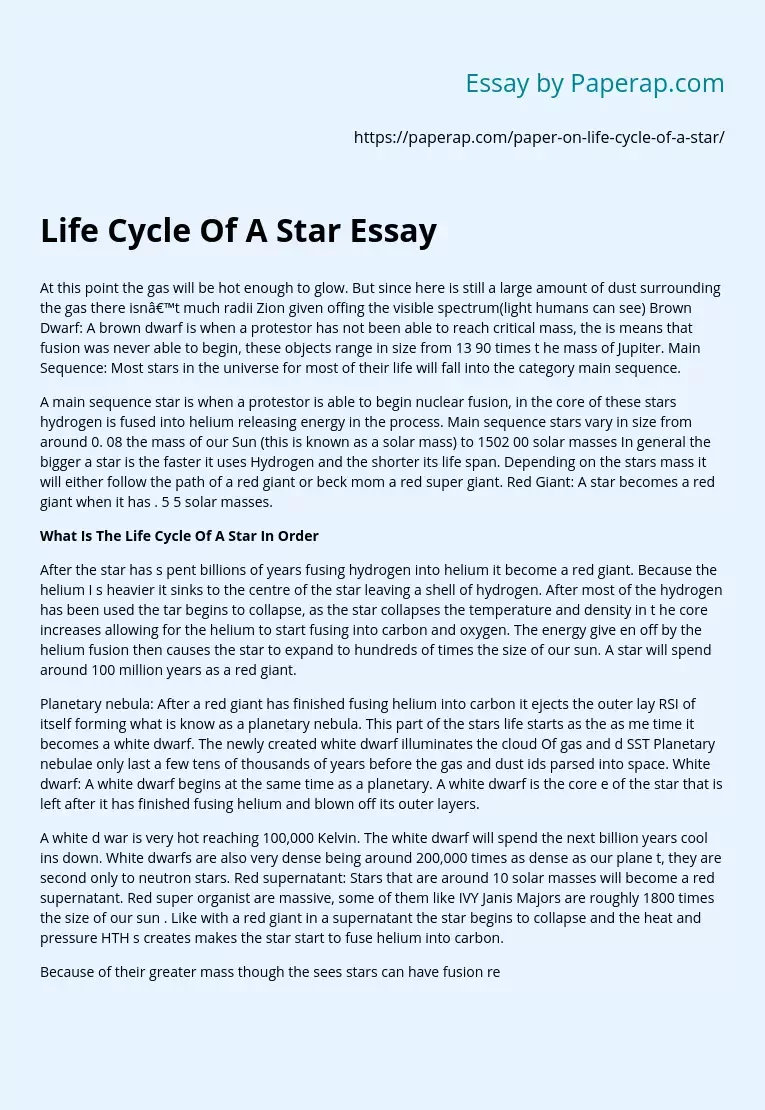At this point the gas will be hot enough to glow. But since here is still a large amount of dust surrounding the gas there isn’t much radii Zion given offing the visible spectrum(light humans can see) Brown Dwarf: A brown dwarf is when a protestor has not been able to reach critical mass, the is means that fusion was never able to begin, these objects range in size from 13 90 times t he mass of Jupiter. Main Sequence: Most stars in the universe for most of their life will fall into the category main sequence.
A main sequence star is when a protestor is able to begin nuclear fusion, in the core of these stars hydrogen is fused into helium releasing energy in the process. Main sequence stars vary in size from around 0. 08 the mass of our Sun (this is known as a solar mass) to 1502 00 solar masses In general the bigger a star is the faster it uses Hydrogen and the shorter its life span.
Depending on the stars mass it will either follow the path of a red giant or beck mom a red super giant. Red Giant: A star becomes a red giant when it has . 5 5 solar masses.
What Is The Life Cycle Of A Star In Order
After the star has s pent billions of years fusing hydrogen into helium it become a red giant. Because the helium I s heavier it sinks to the centre of the star leaving a shell of hydrogen. After most of the hydrogen has been used the tar begins to collapse, as the star collapses the temperature and density in t he core increases allowing for the helium to start fusing into carbon and oxygen.
The energy give en off by the helium fusion then causes the star to expand to hundreds of times the size of our sun. A star will spend around 100 million years as a red giant.
Planetary nebula: After a red giant has finished fusing helium into carbon it ejects the outer lay RSI of itself forming what is know as a planetary nebula. This part of the stars life starts as the as me time it becomes a white dwarf. The newly created white dwarf illuminates the cloud Of gas and d SST Planetary nebulae only last a few tens of thousands of years before the gas and dust ids parsed into space. White dwarf: A white dwarf begins at the same time as a planetary. A white dwarf is the core e of the star that is left after it has finished fusing helium and blown off its outer layers.
A white d war is very hot reaching 100,000 Kelvin. The white dwarf will spend the next billion years cool ins down. White dwarfs are also very dense being around 200,000 times as dense as our plane t, they are second only to neutron stars. Red supernatant: Stars that are around 10 solar masses will become a red supernatant. Red super organist are massive, some of them like IVY Janis Majors are roughly 1800 times the size of our sun . Like with a red giant in a supernatant the star begins to collapse and the heat and pressure HTH s creates makes the star start to fuse helium into carbon.
Because of their greater mass though the sees stars can have fusion reactions that create elements up to iron. Like main sequence stars the bigger the star the shorter. A supernatant life is around few 100,000 1,000,000 years Us persona: A supernova is the how massive stars end their life, a supernova will very brie fly prod cue more light than the entire galaxy. As the red supernatant was ending its life fusing he aver and heavier elements they built up in bands with the heavier elements at the core, Once t he star passes a certain mass known as the Chandeliers limit the star begins to collapse.
The e shock wave caused by the collapsing of the star eventually reaches the core and bounces back. The showplace bouncing back causes the star to explode in a supernova and in the is very brief time all the elements heavier than iron are created. After the supernova almost all of the star has been blown off and what is left is an incredibly dense core. Neutron star: A Neutron Star is the core left over from a supernova, they have a mass Of are undo 1. 4 solar masses and only have a diameter of 20 kilometers.
Life Cycle Of A Star Essay. (2019, Dec 05). Retrieved from https://paperap.com/paper-on-life-cycle-of-a-star/

